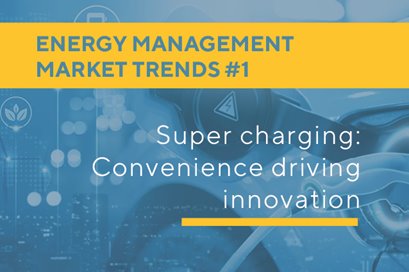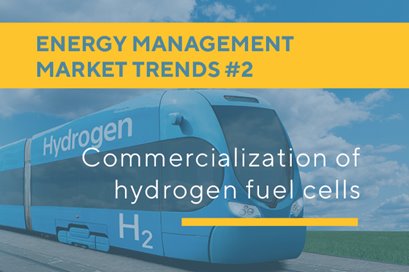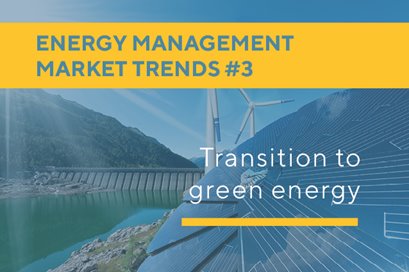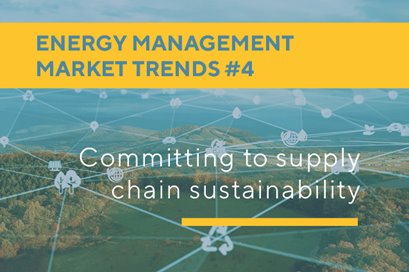When we look back on 2022, we’ll remember a year when energy prices soared. When geo-political tensions drove governments to strive for energy independence and resilience with renewed sense of urgency. When climate change goals required everyone to think differently about the energy they consume. As we look forward into 2023, what is the outlook for the energy management market?
Innovators, product developers and manufacturers can look forward to new opportunities. They can change how we capture energy and consume it. They can work to reduce our collective impact on the planet. We asked our team what they are hearing from the sector as we head into 2023.
Here are four energy management trends we’re tracking.
Trends in Energy Industry: The growing need to supercharge

Mark Mackay, Business Development Director
Today, electric cars (EVs) represent approximately 1% of global car stocks meaning there are more than 10 million EVs on the road. Revenue predictions for EVs show an annual growth rate (CAGR 2022-2027) of 18% resulting in a projected market volume of USD 869 billion by 2027. Electric trucking was valued at USD 505.5 million in 2021. The market is projected to grow from USD 631.3 million in 2022 to USD 7,146 million by 2029, exhibiting a CAGR of 41% during the forecast period. The electric construction equipment industry is estimated to grow from USD 9.2 billion in 2022 to USD 24.8 billion by 2027, a CAGR of 22%. Governments are encouraging drivers to switch to electric by introducing incentives in the forms of grants in the UK and across the majority of the European Union’s member states and federal tax credits in the United States.
As more and more drivers make the switch to electric, there are clearly opportunities for those developing super- or even hyper-chargers to keep all these car, trucks and heavy equipment on the road. Developers need to move quickly, with the right technology to become leaders in this growing space. Opportunities will extend beyond chargers to technology that captures and stores energy efficiently. Whether that’s using offshore wind to power hydrogen fuel cells, which can store and move energy, or co-locating solar farms with charging stations to facilitate destination charging, thus ensuring energy availability.
One challenge for companies hoping to take advantage of these opportunities is the limited availability of silicon carbide. This is required to power core module technology for all chargers and vehicles. Having a scalable supply chain solution with a focus on reducing risk and facilitating growth will be crucial to take market share.
Trends in Energy Industry: Development of hydrogen fuel cells for trucking, heavy equipment and rail

Rich Latta, Director of Manufacturing Solutions
The first hydrogen powered trucks in Europe rolled into action in 2021. For many trucking and heavy equipment manufacturers, moving straight to hydrogen cells rather than opting for electrification will make more sense. It will avoid the need to stop and charge frequently. A combination of electrification and hydrogen fuel cells will provide greater range and less frequent charging, making their equipment more attractive to buyers. The opportunities and challenges for this new technology are numerous. As we consider what a hydrogen fuelled heavy transportation market will look like, two key areas stand out:
- As hydrogen has a lower ignition energy than fossil fuels, the risk of combustibility and electric shock rises. Building in the right safety measure for these products will increase their commercialization potential.
- Building in cost reduction to bring this new technology to the right price point will make it a viable option for mass marketing. Utilized effectively, Design for Excellence methodologies will help to achieve this.
Trends in Energy Industry: Maintaining focus on global energy transition in the face of global instability.

Ramie Smith, Senior Director Industrial - EMEA
Initially we might see a backwards trend in this area, particularly in countries where governments are prioritizing reducing energy bills for consumers and businesses alike, or facing greater demand than their supply can meet. We have already seen this in Germany where parliament approved measures to use mothballed coalmines to produce electricity, leading to major protests from climate change activists.
Longer-term, the need to ensure energy independence, avoid future price rises and decarbonize will drive a move away from fossil fuels to greener, renewable alternatives. Supporting the transition from oil and gas to renewable energy will require all stakeholders from the power companies, governments, manufacturers and innovators across the energy sector to work collaboratively. The vast scale-up of battery-based electricity storage infrastructure is widely seen as central to global net-zero ambitions. Harvesting energy from renewable sources and converting it into useable power will require the wide deployment of new technologies and investment in national grids. This will include power electronics, high voltage equipment, including HVDC (High Voltage Direct Current Electricity) Systems, automation and protection products and asset management equipment to monitor performance. When developing technology in each of these areas, companies need to remember the energy trilemma of balancing affordability, reliability and sustainability.
Trends in Energy Industry: Supply Chain Sustainability: committed to reducing scope 3 emissions

Megan Schleicher, Senior Director - Environmental, Social and Governance
With the global focus on climate change more urgent than ever, companies are increasingly focusing on the sustainability of their supply chain. This includes seeking to reduce Scope 3 emissions - indirect emissions that occur because of the companies’ operations, but from sources not owned or controlled by the company - and de-risk. When bringing new energy management products to market, each member of the supply chain needs to behave in a socially and environmentally responsible way. Specifically from an environmental perspective, you should consider:
- Regional/Global Growth – how will you be able to deliver your product sustainably within minimum carbon footprint in different regions? How will you be able to cope with demand fluctuation across regions, do you need to consider relocating?
- Product Design – consider the decisions you make in early product development and the long-term environmental impacts those could have.
- Supply chain configuration - which suppliers are at most risk from the impact of climate change or fluctuating energy prices?
Applying this thinking will not only deliver from a sustainability perspective, but also increase resilience and de-risk your supply chain.
Faced with these trends: Are you ready to make the most of the opportunities?
There will be considerable new opportunities for energy management companies in the short and longer term as the world focuses on decarbonization. You need to make sure you have a strategy that combines agility with a financial and technical solution that will enable you to win your unfair share of these opportunities. Selecting the right partner to support your journey, whether that’s design and development, manufacturing or sustaining services, will provide you with expertise, capability and capacity so that you can maximise your market share, return on investment and minimize your risk.
At Plexus, we have decades of experience in supporting energy management companies take their products to market. It’s our mission to help you create the products that build a better world. If you are ready to talk to Plexus about how we might support your growth and journey towards a more sustainable supply chain, we’re ready to hear from you.